
After several days of foggy, windy weather we left Port aux Basques to cruise along the southwest coast of Newfoundland. The talk in the harbour was that there were quite a few yachts cruising the coast this year, partly (at least) due to the fine weather that the whole region had been enjoying.
A quick look at AIS tracking site Marine Traffic seemed to confirm this with quite a number of pleasure craft showing up along our intended route. This left us a little apprehensive about finding space in some of the smaller anchorages, but in the end that proved to be no problem at all.
The reality is that when there are a number of boats in an area they often form ‘clusters’ in anchorages and ports due to weather conditions. Then as all boats tend to leave at the same time when a weather window opens, they move in tandem. If you are not in that loop you may never catch them up.
We had heard that there were five boats anchored in Squid Hole, Isle aux Morts, for example, just around from Port aux Basques, but when we got there the place was empty, just to prove this point.
The first thing to go is always the plan….
On the way across from Cape Breton we had been fast reaching in lumpy conditions and, as is our usual strategy, we had partly raised our centreboard to make the boat steer easier and reduce drag. And again, as usual, we pumped the board back down when we came on to the wind in the approach to Port aux Basques to maximise our upwind potential.
When I went through my usual post-passage check-over of the boat I was surprised to find that somewhere along the way we had lost some fluid from the hydraulic system that controls our centreboard and rudder.
Unsure as to whether we had simply had an airlock that had cleared in the rough conditions, I topped up the reservoir and pumped up the rudder and board a few times to check that all was well.
To our great disappointment we found that we were losing a small amount of fluid every time we pumped the board up—we obviously had a leak somewhere, probably from the seals in the ram. And there was no way of confirming this without lifting the boat out of the water and opening up the centreboard box.
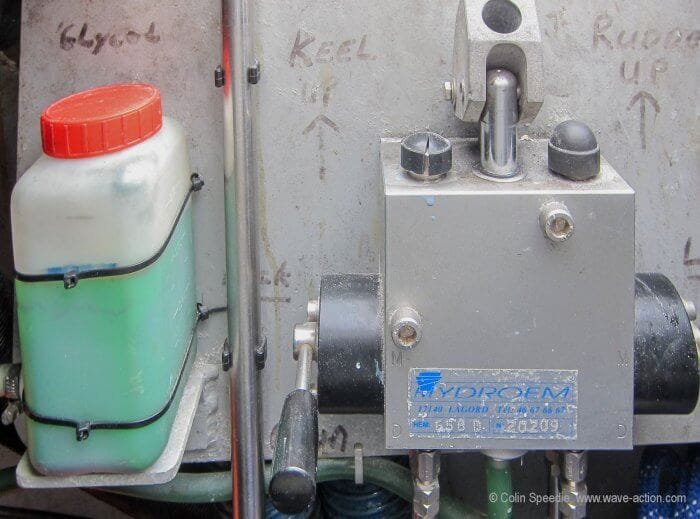
This is the worst type of problem you can face, especially far from home and help—we reckoned that the nearest working travel hoist was many miles away in Fortune. Whilst we carry a used ram in working condition, it’s still a major job to remove and replace the offending item, so it wouldn’t be a five-minute job.
This is the cruising life: sometimes you have to make tough decisions. Was there a likelihood that it would suddenly, catastrophically fail? No.
So we decided to monitor the situation, avoid bad weather, and make our way steadily east towards Fortune and see whether it was necessary to haul the boat and abort the cruise. We hoped that with the board down and locked into position there would be no fluid loss—fingers crossed. So off we went.
The Hole In The Wall
We arrived with a stiff southwesterly breeze funnelling up through the channel and swept past the narrow entrance to Squid Hole to see how much room there was, before rounding up and battling back into the wind and chop to check out the entrance more closely before committing ourselves to entering—it did look awfully narrow and the wind would be on our beam…
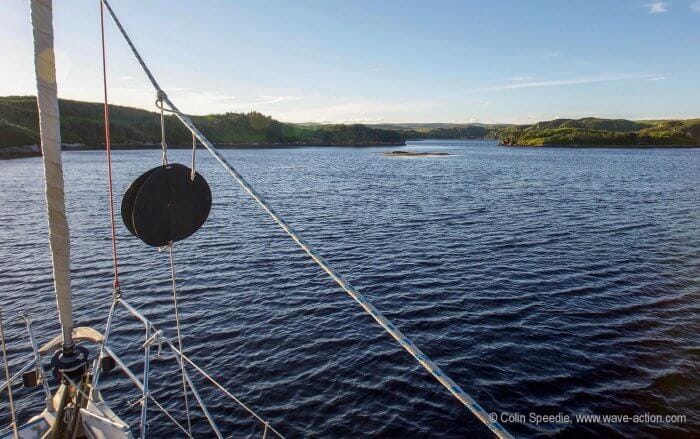
In the end we decided it looked doable, with the only option being to get some speed on and just go for it if the wind wasn’t to catch us and blow us down onto the islet in the entrance. Our Ovni simply doesn’t like strong crosswinds and will blow sideways like a leaf if not enough forward momentum is carried.
Another nerve-tingling moment in a lifetime of the same, but Louise handled the boat with her usual aplomb and we shot through the entrance into a calm pond and rounded up to drop our hook in the best spot in the anchorage. Time stood still. Up on the hills around us local people were foraging for berries and a merlin falcon swept across our masthead like a tiny arrow. We’ll like this place, we thought.
Back To The Voyage In Hand
Happily, the fog that had plagued us so much this season seemed to be giving us a break at last and we set off the following morning from Isle aux Morts in light winds to head east along the coast.
By now we had got used to the idea that the local wind forecasts were not to be entirely trusted and that there were often currents in unexpected places, so we were not surprised to find that the forecasted southerly was in fact an easterly.
A Great Weather Resource
We should have been better informed, because we had downloaded a pdf of local weather lore by Environment Canada Senior Meteorologist Peter Bowyer, but we hadn’t had a chance to read it. Once we did, much that had previously been fuzzy snapped sharply into focus. It seems that there are many local wind and tidal anomalies that are not otherwise advertised, such as the ones we had just met first hand.
Reading up in advance on a new cruising ground is always a good idea and not just the very necessary practical stuff like cruising guides or weather guidance.
Books About The Place
Art, culture and local concerns also help to prepare a mental route map to enable us to get the most out of our visit. So I had two books on the go while we sat out the weather in Port aux Basques that hit the spot perfectly as far as I was concerned.
The first was Mark Kurlansky’s seminal book Cod on the fish that built nations. Kurlansky details in great depth the most amazing story about the destruction of a seemingly inexhaustible natural resource in a matter of a few centuries.
The final sections of the book detail the crazy decisions that allowed completely unrealistic fish quotas for the big fishing vessels out on the Grand Banks even as stocks collapsed. Decisions that in turn had direct implications on the livelihood and future of the people and places we would be passing through this summer.
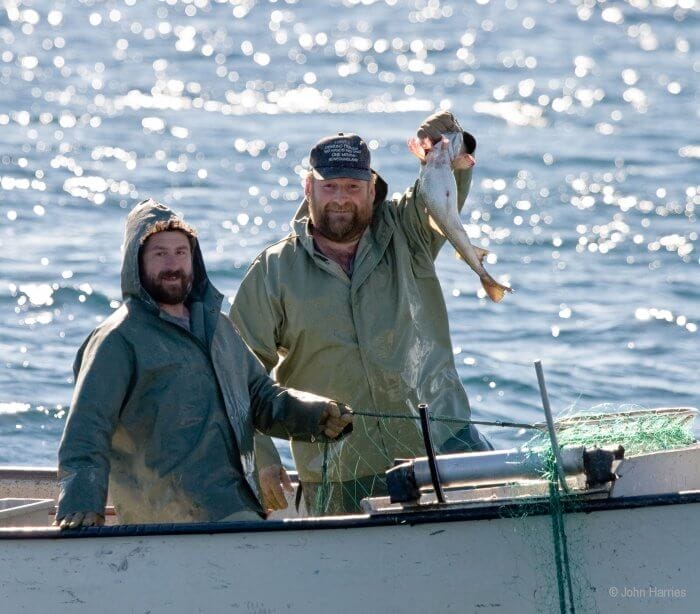
Effectively, the outports along this coast relied on inshore fishing for cod from small boats and when the major stocks farther offshore were exhausted by super trawlers and factory ships the end was nigh for the inshore fishermen and a harsh way of life that had sustained them since at least the 1700s. As a parable about resource depletion and its knock-on effects it should be taught in every school around the world.

The second was a very different read, Farley Mowat’s Bay of Spirits: A Love Story. Published in 2006, this book recounts his meeting the woman who would become his second wife and their adventures in the 1950s sailing their schooner the Happy Adventure through the outports along the southwest coast and their years of living in Burgeo.

Theirs would be a very different perspective from ours, given that they were present during a time when there were many more active outports, cod fishing was still viable, and electronic gizmology like GPS was the stuff of sci-fi fantasy.
His observations about the people and places are vivid and affectionate and even the event that caused their fall from Eden (which I won’t spoil for you) is better explained with the benefit of many years of hindsight in which he had time to consider the rights and wrongs of his actions. As the dedication in the book says: “A love affair with a special woman and a special world”, which sums it up exactly for me.
So Let’s Go and See It
By evening we were closing with our intended destination, Grand Bruit, an outport that was resettled in 2010. We had heard that there were still a few locals who had opted to maintain their old homes as summer residences and that the fabled Cramalot Inn, a tiny unofficial drinking hole on the quayside, was still sometimes occupied with a smattering of visitors and ex-locals. That sounded like it might be fun and there was also the childlike thrill involved in the thought of visiting an abandoned settlement.
From a distance the town looked intact and unchanged. In a couple of gardens washing still flapped listlessly, but we noticed no other sign of life. As we entered the small harbour the source of the “grand bruit” (great noise in French), a substantial waterfall that ran through the middle of the town, could be heard and we could get a better view of the state of the place.
A few of the houses still looked well cared for, but the slow, steady deterioration of the others told its own story. And the same could be said for the wharf, which was also rapidly falling into disrepair.

Close up, an air of sadness hung over the place and our plans for going ashore evaporated almost instantly. This was a place where people lived and loved, shared their hopes and fears, and where the quaysides echoed to the sound of children’s laughter, not just the noise of the waterfall.
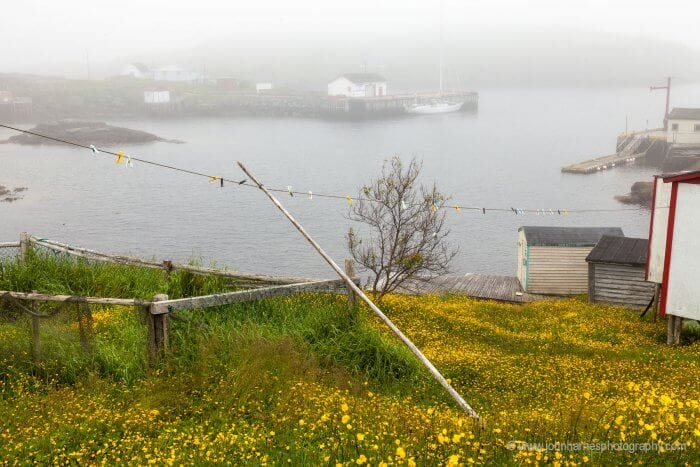
We agreed that we’d feel like trespassers wandering through such a sad and spooky place and slowly turned away, slightly shaken by the intensity of our feelings.

On To Somewhere Less Busy
As always, we had a Plan B in mind, Culotte Cove in Cinq Cerf Bay, which looked really lovely. Almost totally enclosed, with no houses in sight, this was more our sort of place.
As we rounded up and quietly motored up to the head of the cove, an otter swam alongside, taking no notice of the tin interloper entering its realm. We anchored up at the head of the cove off a small white sand beach and as the engine was shut down we were immersed in total peace. Sitting in the cockpit later we watched a caribou pick her way unhurriedly down the rocks no more than 50 m away, stopping to nibble at patches of vegetation as she went.
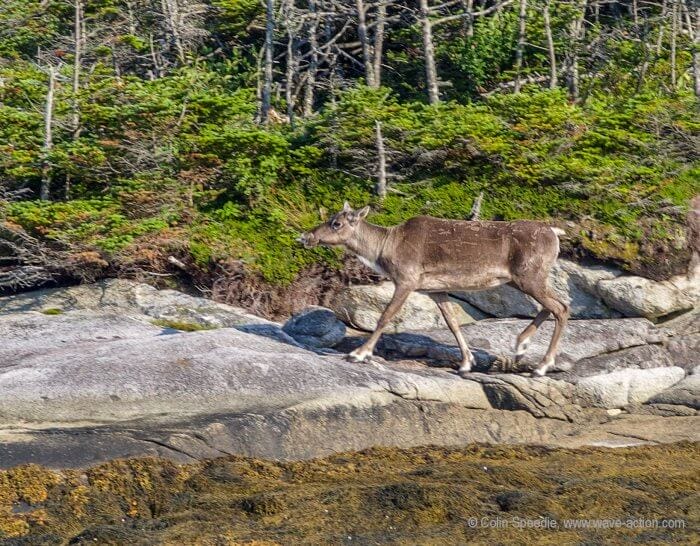
And as the sun went down at the head of the Cove and a limpid, starlit sky engulfed Pèlerin, we were glad to be back among natural solitude and not the tragedy of resettlement. People come and go, but the rocks remain.

Hi Colin.
Beautiful and intriguing descriptions. Makes me want to go there.
Hi Stein
it’s a wonderful area – don’t miss it if you get the chance
So true of all of Newfoundland & Labrador…but your young moose is a caribou. We are anticipating returning ASAP.
Hi Jayne
I’m more of a marine guy so please forgive my error – thanks for pointing it out.
Hi Jayne,
Oops, we editors should have caught that one. Fixed now and thanks for the correction.
My wife’s late grandmother babysat Farley Mowat in Belleville, Ontario in the early 1930s, which is just about the most Canadian thing ever. If you liked his work, there’s a great deal of it set on or near the sea. Thanks for a great insight on some rarely discussed and probably rarely visited cruising grounds…and I hope the hydraulics issue has been resolved.
Hi Marc
great story – maybe she had some influence on the young Farley!
I haven’t read many of his books, but those I have I’ve greatly enjoyed.
And we got back OK, although we couldn’t fix the problem until we got to Mahone Bay at the end of the season.
Nice read Colin, I was surprised that Burgeo didn’t have a travel lift. We sat out a gale 10 years ago inside it’s slipway since they had no one to haul. Also Bay of Spirits is a must read if you want a solid understanding of Newfoundland. Thanks we spent 4 months there and in Labrador and loved it all. Can’t wait to to read more.
Jim
Hi Jim
from what I heard the travel hoist became more and more decrepit with descending weight limits as time went by. Presumably this was due to the number of lifts required diminished due to the problems with the fishery. I think it’s out of action now altogether and we also heard that the next travel hoist east of there had recently closed – another sign of the times, perhaps?
Colin
Hi Colin,
Sadly it looked to us as if the lift in Fortune is going the same way, so just as well you were not forced to rely on that. On the bright side the marine service centre in Fermeuse is going great guns and the lift looked well cared for.
Hi Colin
I follow your posts with great interest as I have a new to me Ovni 435 over here in Australia.
It is all a big learning curve as this is my first boat. It is great to have your wealth of experience on how you have set up Pelerin.
My Hydraulic pump is exactly the same as yours except I have a pink coloured automatic transmission fluid (Dexron ) in the reservoir chamber. I presume your fluid is antifreeze.Do you have any information regarding what fluid or fluids are compatible with system.
Cheers Neil
Hi Neil
the usual fluid is Ethylene glycol mix, which is what we use. It may be that the ATF you’re using is OK, but it might be wise to check with Hydroem (who made the pump and rams). I’d want to know that it wouldn’t attack the seals myself.
Colin
Hi Colin,
thanks for a good story well told. How I long to visit NFL again, your reports spur me on.
And just in case you haven’t read Mowat’s “The boat who wouldn’t float”, dont miss it, it’s a source for endless chuckling.
Hi Hans
I’ve got that book on my winter reading list!
Colin
Hi all,
I resisted wading in with an all-time-favorites list of Farley Mowat readings as he is a favorite author and he has a very wide range of writing interests and I can get carried away.
And I agree that anyone visiting Newfoundland (by sea or by land) would benefit by reading “Bay of Spirits”. And one of the 2 or 3 funniest books I have ever read is “The Boat Who Wouldn’t Float”.
And I cannot resist another recommendation: for adventure, read “Grey Seas Under” about an actual salvage tug and its true exploits out of Halifax, Nova Scotia, rescuing ships in trouble all over the N Atlantic during the end of the depression and WWII. All are great reads.
My best, Dick Stevenson, s/v Alchemy
I have a secondary blog to the refit one in which I occasionally review sea-oriented books I’ve enjoyed. One is this very volume, which I also strongly recommend: https://volumesofsalt.blogspot.com/2011/05/tale-to-tug-at-heartstrings.html
Also try “The Captain” by Jan de Hartog!
Best wishes,
Charles
Charles L Starke MD
s/v Dawnpiper
Thank you Dick and Marc
another book for the list of future good reads!
Colin,
Great story…
Keep us updated with how your fluid loss pans out. It is something that does concern me. Could be an awkward job to replace damaged hoses or the ram. At least its weight will hold it down, unlike the rudder. I recently drilled a hole in the skeg so that a bolt could be installed to lock the rudder down in the event if a ram/hose failure on the rudder. It would take a dip over the side to get it locked, but could be done in an emergency.
Garry
Hi Gary
I’ve seen a few French Ovni’s with drilled holes for a bolt in the rudder as you have done – a perfectly serviceable solution.
We have a hole in the bottom corner of the leading edge of the lower section of the rudder that we can attach a Dyneema loop through and lead up to the aft cleats to do the same, but it’s more of an emergency ‘get out off jail’ affair. We also have a hole in the leading edge of the centreboard to fulfil the same purpose.
As for how things panned out? See the next instalment…
Culotte Cove is indeed a lovely spot: well protected, good holding, with some wonderful walks along the surrounding bluffs and a beach to careen one’s vessel should she need it. In addition there is a totally protected bolt hole just around the corner in North-east Arm where I have ridden out hurricane force winds in comfort and safety moored (with a cat’s cradle of lines) behind the small island at the head of that arm. Apart from the small group of caribou that are often to be seen in Culotte Cove, I have seen moose and a pair of golden eagles in the area. The area embodies all I like most about Newfoundland and Labrador.
I have used the beach at the head of Culotte Cove on three occasions to careen before an ocean passage – once before sailing for Scotland, once before sailing for Ireland and once before sailing to the Caribbean. The beach is white silica and an oddity in Newfoundland; it looks artificial and probably is. I believe it is formed from the tailings of a long-abandoned gold mine formerly situated at the head of Culotte Cove. No trace now remains of the mine except the crushed quartz that forms the beach and a steel pole set in a concrete base. The mine used cyanide to extract the gold and it would be unwise to fill your tanks from the stream at the head of the bay. There is a good watering stream nearby in Betty Cove that is does not drain from the site of the mine.
Most of this information should be available in the CCA Guide to Newfoundland – I sent it to them together with a set of sketch charts but am too poor to buy the guide just to see if it has been included in the later editions.
I hope to visit Culotte Cove again next summer, and will undoubtedly careen on that beach, water in Betty Cove and fill the firewood locker from the surrounding hills.
Hi Trevor
it is indeed a lovely spot, and the beach is, as you say, unusual and a really eye-catching feature. We saw the pole up at the head of the beach and wondered what had put it there, and the presence of the disused mine makes sense in regard to the deposition of the beach.
Your charts and comments are indeed in the latest version of the CCA guide, for which we (and all others visiting in future) owe you a debt of gratitude. Like you (but less prolifically) we always send any details we have found in new cruising areas to the relevant publisher of the local guide. Thanks for setting such a good example.